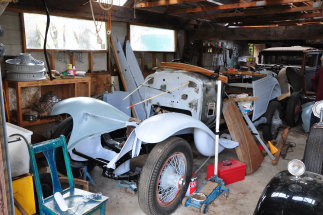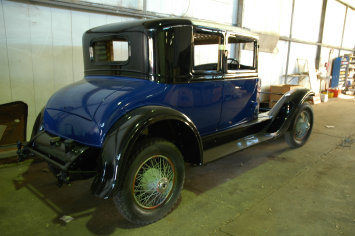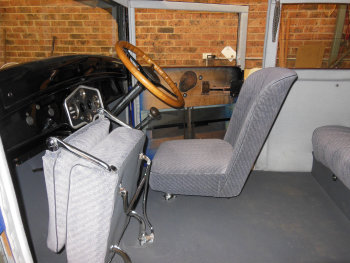The early history of Ava is unknown, which is a shame, as we’re sure she has quite a story to tell, but there are some tantalising hints.
Officially, Ava is a LaSalle 5-passenger Coupe (metal back), style number 8050, first announced in January 1928. There were 1001 vehicles of this style built in 1928, of which five were made for export, so Ava is not just one in a thousand, she’s one in five.
As mentioned, we have not been able to trace her early history and her recent story starts in the early 1970s when she was retrieved from an open paddock in the outer Melbourne area of Victoria. Her owner at that time had planned to place her body onto the chassis of a European car, but this never came to fruition. She then moved to a semi-rural property in Emerald, Victoria, where she was stored in a shed which she shared with some donkeys. Over the years the donkeys caused considerable damage to the body and ultimately, the owner decided he would not be able to restore her and in 1993 she was sold to a skilled vintage car restorer in New South Wales.
Ava was in quite a sorry state when she left the donkey paddock: a chassis, steering wheel, part of the body, a few remaining scraps of wooden frame and an engine block. However, the man who purchased her saw great potential and set about rebuilding her. The body was removed and what metal was salvageable was kept. The chassis was sandblasted and painted and the wooden artillery wheels were replaced with wire Buffalo wheels. Then the time-consuming task of rebuilding her wooden frame began. Building a body takes considerable skill and a lot of patience, as the timber has to sit exactly on the chassis and also fit the metal body which is attached to it. The irony of all this work is that no-one will ever see the finished product once the upholstery is fitted. Once the wood was complete, the rebuilding of the metal body began. It was at this point that the owner decided to sell the partially restored vehicle and my brother and I bought it.
Ava stayed in our shed for a few years together with some of the other semi-restored cars we purchased around that time as we decided how to proceed with the restorations and which vehicle to start with. In 2011 we moved all the vehicles to a large workshop in Windsor and determined that Ava was the most advanced of the vehicles we had and should be the first to be restored. We engaged a master coachbuilder, Bob, to fit the body to the chassis and attach the metal skin to the wood. We had to fabricate the boot, the wooden slats to hold the canvas roof, attach the new mudguards and hang the doors so they would close smoothly.
Once all the metal parts had been fitted, the rolling chassis was delivered to our painter and the body was stripped back to bare metal, all rust spots removed and any pits or dents were panel beaten and smoothed over to create a car that looked as if it had just left the production line. Barry then started to work his magic on the bare metal canvas. Again, after reviewing other vintage wedding cars around the world, we decided on a dark blue body, with contrasting black mudguards and black window surrounds and roof. The colour is close to an original Cadillac factory colour called Manchester Blue, which was available in the period.
At this point it was time to look at fitting the engine and gearbox, add the new wiring harness and fit the numerous incidental pieces such as headlights, taillights, blinkers, dashboard, brakes, canvas roof and think about the interior upholstery. To that end, Ava was loaded onto a car trailer and shipped to our restorer in Wyong, where the next and final stage of the restoration began. It was here that we encountered a serious problem with Ava’s chassis. Our restorer, Robert, decided to do a check on the trueness of the chassis and when he measured the wheelbase on either side of the vehicle, there was a 2″ discrepancy between the two sides. While it wasn’t apparent when we assembled the body, the chassis had a serious warp or bend. Time for Plan B.
We had earlier purchased a partially restored vehicle which had a rebuilt engine, gearbox and differential and this was to be the donor vehicle for Ava’s engine and gearbox. As it happened, the chassis on this vehicle was the same length as Ava’s, so the decision was made to swap Ava’s body onto this chassis. While some might wonder why we didn’t think about this earlier, it is much easier to swap an engine than a body, both in terms of time and frustration. However, in this case, if we wanted a perfect vehicle, this was what we had to do.
The final step was to install the new upholstery. We decided on a classic grey velour which could easily have been what Ava was originally clad in. The seat bases were fabricated, new springs fitted and the roof lining and side lining installed. The original seat stuffing would have been horsehair, but that would have been difficult to source and probably not politically correct, so we went with modern materials. We are confident it won’t affect the comfort of the seats. The finishing touches were the interior lights and plaited hand grips to enter and exit the vehicle.
Finally, after more than a decade of work, Ava was road-ready in February 2015 and completed her first wedding, the first of many to come.
Now that tantalising hint about Ava’s early history: the noted vintage and veteran car historian, Harold Paynting, author of the James Flood series of books on early Australian motoring, remembered seeing a car of Ava’s description parked in the Melbourne CBD before World War 2. The vehicle was memorable because it was painted in two shades of pink, which was a factory colour option in 1928. The owner from Emerald remembered some areas of pink paint on Ava’s body, but always assumed they were primer.
Was Ava the car Harold Paynting saw in Melbourne all those years ago? We will never know, but we like to think she was.
It has been a long and time-consuming journey to bring Ava from the two donkey-powered wreck in a paddock to the beautiful wedding car you see now. However, we believe the journey has been worthwhile and we hope you enjoy Ava as much as we do.
If you think that Ava or any one of our other beautiful vintage Cadillac – LaSalles would be the perfect complement to your wedding day, please contact us for details.







